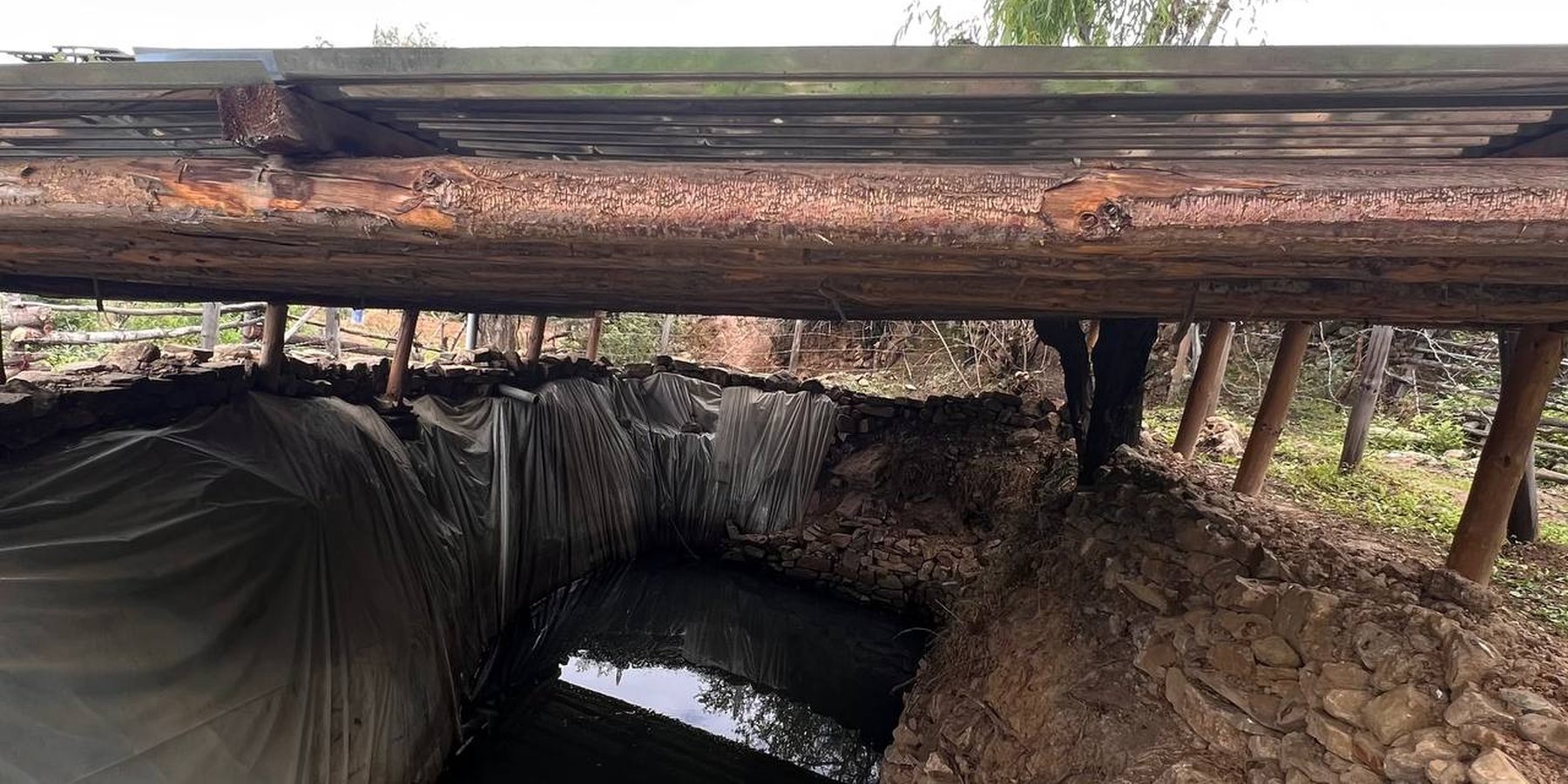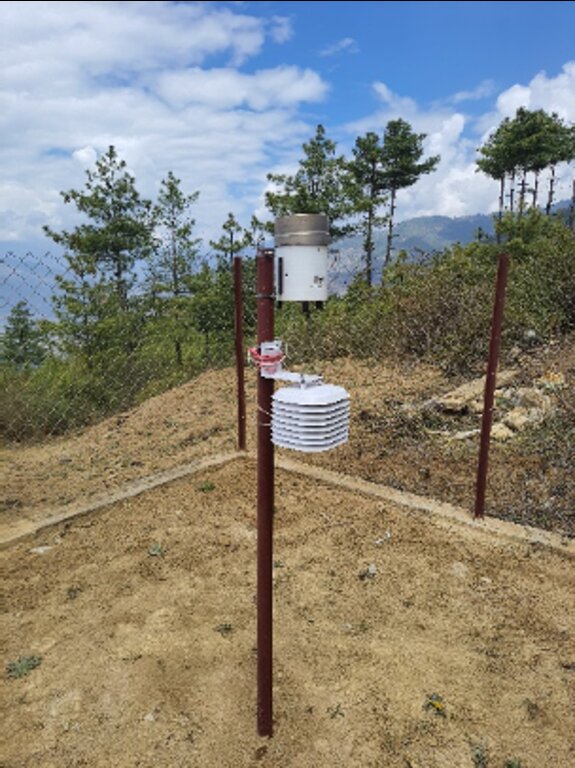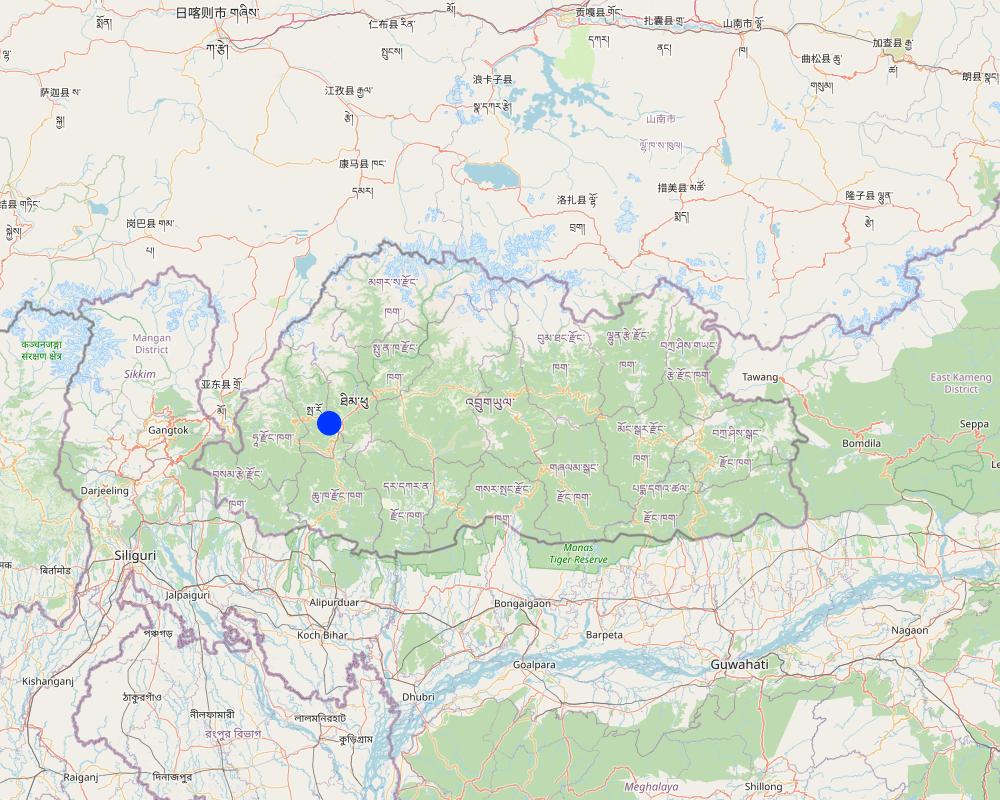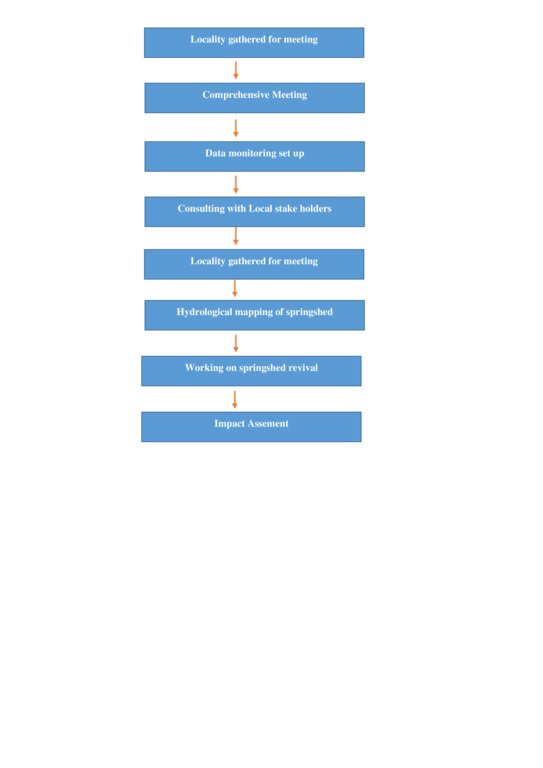Nature-based Solutions for Springshed Revival [Бутан]
- Создание:
- Обновить:
- Составитель: Karma Wangdi
- Редактор: Haka Drukpa
- Рецензенты: Rima Mekdaschi Studer, William Critchley
Rangzhin Thablam Thok Chhuka Sakhong Nyamsuung (རང་བཞིན་ཐབས་ལམ་ཐོག་ཆུ་རྐ་ས་ཁོངས་ཉམས་སྲུང་།)
approaches_6850 - Бутан
Просмотреть разделы
Развернуть все Свернуть все1. Общая информация
1.2 Контактные данные специалистов и организаций, участвующих в описании и оценке Подхода
Ответственный (-ые) специалист (-ы)
землепользователь:
Dorji Gem
n/a
Lholing, Shaba Gewog (Block), Paro Dzongkhag (District)
Бутан
землепользователь:
Chencho Chencho
n/a
Lholing, Shaba Gewog (Block), Paro Dzongkhag (District)
Бутан
землепользователь:
Dorji Chencho
n/a
Lholing, Shaba Gewog (Block), Paro Dzongkhag (District)
Бутан
землепользователь:
Nidup Wangmo
n/a
Lholing, Shaba Gewog (Block), Paro Dzongkhag (District)
Бутан
Название проекта, содействовавшего документированию/оценке Подхода (если применимо)
Strengthening national-level institutional and professional capacities of country Parties towards enhanced UNCCD monitoring and reporting – GEF 7 EA Umbrella II (GEF 7 UNCCD Enabling Activities_Umbrella II)Название организации (-ий), содействовавших документированию/оценке Подхода (если применимо)
National Soil Services Center, Department of Agric (National Soil Services Center, Department of Agric) - Бутан1.3 Условия, регламентирующие использование собранных ВОКАТ данных
Когда были собраны данные (на местах)?
12/07/2023
Составитель и ответственный/-ые специалист(-ы) согласны с условиями, регламентирующими использование собранных ВОКАТ данных:
Да
2. Описание Подхода УЗП
2.1 Краткое описание Подхода
Springshed revival can be achieved through Nature-based Solutions (NbS) with a hydrogeological approach, complemented by socio-ecological inputs, and engineering surveys.
2.2 Подробное описание Подхода
Подробное описание Подхода:
Springs are natural occurrences where fresh water emerges from the ground through openings known as spring vents. They are outlets from aquifers, water-bearing layers underground, to the surface. The water in springs originates from rainfall during specific seasons, which falls on the springshed, infiltrates the ground and is collected as groundwater. When the groundwater is pressurized and rises, it creates springs, which then contribute to the flow of water into rivers or other water bodies. In mountainous regions like Bhutan, springs serve as the primary water source for rural households (ICIMOD, 2021).
Spring revival through “nature-based solutions” (NbS) in springsheds refers to a comprehensive effort aimed at reviving and restoring the functionality of springs. The primary objectives of spring revival initiatives include ensuring sustainable water supply, mitigating the threat of springs drying, conserving biodiversity, and improving the livelihoods of communities dependent on spring water. To achieve these goals, diverse methods are employed, involving various stakeholders. While spring revival offers numerous advantages, it also presents certain disadvantages that should be considered (Konek & Samanta, 2022).
The methods used under NbS to revive springs are multifaceted and typically involve a combination of hydrogeological, ecological, hydrological, and community-based approaches. Hydrogeology can lead to a better understanding of aquifers and the nature of springs and springsheds, thus providing ways for better management. Ecological methods focus on restoring the natural catchment area (the springshed itself) and improving vegetation cover to enhance water infiltration and recharge. Measures such as reforestation, contour trenching, and check dams are implemented to reduce erosion, promote groundwater recharge, and maintain spring flow. Hydrological interventions include the construction of recharge structures, groundwater recharge pits, and percolation tanks to replenish the aquifer and ensure sustained spring flow. Community-based approaches encompass raising awareness, capacity building, and participation in springshed conservation and management activities. These efforts often include the establishment of user groups, water committees, and the adoption of sustainable water use practices (Shrestha et al., 2017).
Stakeholders play vital roles in spring revival initiatives. Local communities living in Lholing areas are key stakeholders as they are directly affected by water availability and are actively involved in the preservation and management of springs. Government agencies such as the Department of Water, Department of Forests and Park Services and Gewog Administration provide technical expertise, funding, and policy support. Academic institutions and research organizations contribute scientific knowledge, monitoring, and evaluation, while international agencies and donor organizations may provide financial assistance and expertise.
According to Tamba et al. (2012) the advantages of spring revival are significant and far-reaching. By restoring spring flow, communities get access to a reliable and sustainable water source, which is crucial for their domestic, agricultural, and livestock needs. Spring revival through NbS also contributes to biodiversity conservation, as the presence of flowing water supports diverse aquatic and terrestrial ecosystems, including endemic species. Moreover, the revival of springs enhances groundwater recharge, which can benefit other water sources in the area. The community involvement and capacity-building aspects of NbS initiatives foster social cohesion, empowerment, and the development of local governance structures. Revived springs have the potential to enhance community resilience to climate change by providing water during periods of drought or erratic rainfall.
However, NbS also come with certain challenges and disadvantages. Adequate financial resources and long-term funding commitments are often required, which can pose a challenge in resource-constrained settings. Technical expertise and knowledge gaps may hinder the effectiveness of revival methods, emphasizing the need for capacity building and technical support. The involvement of multiple stakeholders can lead to coordination issues and conflicts of interest. Furthermore, the success of spring revival initiatives relies heavily on community participation. Thus, lack of community engagement or ownership can hinder sustainability. Environmental and social impacts need to be carefully considered, as inappropriate interventions or changes in hydrological patterns can have unintended consequences on ecosystems and communities (Khadka et al., 2019).
2.3 Фотографии, иллюстрирующие Подход
2.4 Видеоматериалы по применению Подхода
Дата:
12/07/2023
2.5 Страна/ регион/ место, где применялся Подход
Страна:
Бутан
Административная единица (Район/Область):
Shaba, Paro
Более точная привязка места:
Lholing Chiwog, Shaba Geog, Paro Dzongkhag
Map
×2.6 Даты начала и окончания реализации Подхода
Год начала реализации:
2018
Если год начала реализации Подхода достоверно неизвестен, дайте примерную оценку:
менее 10 лет назад (недавняя)
2.7 Тип Подхода
- в рамках проекта/ программы
2.8 Каковы цели/ задачи Подхода
Nature-based solution to reviving springs as a source of water for:
1. Drinking
2. For animal use
3. Agriculture
2.9 Условия содействующие применению Технологии/ Технологий в рамках Подхода или затрудняющие его
Социальные/ культурные/ религиозные нормы и ценности
- содействуют
Water became the source of whole existence.
Наличие/ доступность финансовых ресурсов и услуг
- содействуют
This type of project can be brought into action with the help of continued implementation of activities and grants
Институциональные условия
- содействуют
More stakeholders
Сотрудничество/ координация действий
- содействуют
Нормативно-правовая база (землевладение, права на земле- и водопользование)
- содействуют
Water Act of Bhutan 2010
Программные документы/ руководящие установки
- содействуют
Drinking water has been a priority over other usage as per our Act and policies.
Управление земельными ресурсами (принятие решений, осуществление и контроль за выполнением)
- содействуют
The Department of Water and Department of Forests and Park Services have been promoting conservation and management of water resources.
Осведомленность в области УЗП, доступность технической поддержки
- затрудняют
Our farmers usually lacks the knowledge on SLM principle left without assisting in this type of field.
Рынки (для приобретения материалов и услуг, продажи продукции) и цены
- содействуют
The communities have access to local markets to sell their agricultural products.
Объем работ, доступность рабочей силы
- затрудняют
Required huge labour contributions. Labour shortage is a problem
другие
- содействуют
3. Участие и распределение ролей заинтересованных сторон
3.1 Заинтересованные стороны, участвующие в реализации Подхода и их роли
- местные землепользователи/ местные сообщества
A total of 8 stakeholders were involved, only two of them are directly assisting in spring revival
Helped as a labor who have contributed in making trenches and fencing around the shed.
- эксперты по УЗП/ сельскому хозяйству
8 Foresters from the Divisional Forest Office, Paro were involved
Planning, coordinating and providing technical assistance for the spring revival
- местные власти
Gup (Local Chief) and Tshogpa of Shaba Gewog Administration.
Administrative support
- государственные власти (отвечающие за планирование или принятие решений)
Department of Forests and Park Services
Provide technical support
- международные организации
Green Climate Fund, ICIMOD
Provide funding support and tecnnical expertise
3.2 Участие местных землепользователей/ местных сообществ на разных стадиях реализации Подхода
| Участие местных землепользователей/ местных сообществ | Перечислите участников и опишите их вовлеченность | |
|---|---|---|
| инициирование/ мотивация | интерактивное | A person from each household was involved in the initial planning and meeting with the specialists to agree to. |
| планирование | пассивное | The plannings were mostly done by specialists from the forest department. |
| выполнение | внешняя поддержка | Land users/local community were engaged as paid labours. |
| мониторинг/ оценка | интерактивное | Twice a year monitoring is done by the specialists and other minor monitoring is dine by the community around the springsheds. |
| нет | No research was carried out. |
3.3 Схема реализации (если имеется)
Описание:
1. Comprehensive mapping of springs and springsheds.
2. Setting up of a data monitoring system.
3. Understanding socio-economic and governance systems of springs.
4. Hydrogeological mapping.
5. Creating a conceptual hydrogeological layout of the springshed.
6. Classification of spring type, identifying mountain aquifer and demarcating recharge area.
7. Developing springshed management and governance protocols and
8. Impact assessment.
Автор:
Singye Dorji & Tshering Gyeltshen
3.4 Принятие решений по выбору Технологии/ Технологий УЗП
Укажите, кто принимал решение по выбору применяемой Технологии/ Технологий:
- преимущественно специалисты по УЗП после консультаций с землепользователями
4. Техническая поддержка, повышение компетенций и управление знаниями
4.1 Повышение компетенций/ обучение
Проводилось ли обучение землепользователей/ других заинтересованных лиц?
Нет
4.2 Консультационные услуги
Есть ли у землепользователей возможность получать консультации?
Да
Укажите, где именно оказываются консультационные услуги:
- на полях землепользователей
4.3 Институциональная (организационная) поддержка
В ходе реализации Подхода были ли организованы новые институциональные структуры или поддержаны уже существующие?
- да, немного
Укажите уровень, на котором структуры были укреплены или вновь созданы:
- местные
4.4 Мониторинг и оценка
Являются ли мониторинг и оценка частью Подхода?
Да
Комментарии:
Physical on site monitoring and evaluating the springshed
Если да, будет ли данный документ использоваться для мониторинга и оценки?
Нет
4.5 Научные исследования
Были ли научные исследования частью Подхода?
Нет
5. Финансирование и внешняя материальная поддержка
5.1 Годовой бюджет мероприятий по УЗП в рамках Подхода
Если точный годовой бюжет неизвестен, укажите примерный диапазон затрат:
- < 2000
Комментарий (например, основные источники финансирования/ ключевые доноры):
Royal Government of Bhutan funding was released under Ministry of Energy and Natural Resources (erstwhile Ministry of Agriculture and Forests).
5.2 Финансирование и внешняя материальная поддержка, предоставляемая землепользователям
Предоставлялась ли землепользователям финансовая/ материальная поддержка для применения Технологии /Технологий?
Да
Если да, укажите тип(-ы) поддержки, кто ее предоставил и условия предоставления:
The government fully funded the initiative of springshed revival where they even paid N. 700 to the labour helpers that from the community engaged.
5.3 Субсидии на отдельные затраты (включая оплату труда)
- труд
| В какой степени | Опишите субсидии подробнее |
|---|---|
| профинансированы полностью | Paid for the local labourers and also 4 technicals staffs from Department of Forest and Park Services. |
- оборудование
| Укажите, какие ресурсы были субсидированы | В какой степени | Опишите субсидии подробнее |
|---|---|---|
| техника | профинансированы полностью | One Excavator untill the completion of the project. |
| инвентарь/ инструменты | профинансированы полностью | Basic tools such as spades, crowbars and shovel. |
| профинансированы полностью | Lunch and refreshments for all the labourers. | |
- строительные материалы
| Укажите, какие ресурсы были субсидированы | В какой степени | Опишите субсидии подробнее |
|---|---|---|
| Barbed Wire Fence. | профинансированы полностью | For a few bigger springsheds. |
Если труд землепользователя был существенным вкладом, укажите, был ли этот вклад:
- за денежное вознаграждение
Комментарии:
The labour by land users were paid Nu. 700 per day with free lunch and refreshments.
5.4 Кредитование
Предоставлялись ли в рамках Подхода кредиты на мероприятия УЗП?
Нет
5.5 Другие методы или инструменты стимулирования
Использовались ли другие методы или инструменты стимулирования для продвижения Технологий УЗП?
Нет
6. Анализ влияния и заключительные положения
6.1 Влияние Подхода
Сумел ли Подход расширить возможности местных землепользователей, повысить участие заинтересованных сторон?
- Нет
- Да, немного
- Да, умеренно
- Да, существенно
The approach helped local land users understand about some basic Knowledges in springshed management and maintenance.
Сумел ли Подход дать возможность принимать решения на основе подтвержденных фактов?
- Нет
- Да, немного
- Да, умеренно
- Да, существенно
Yes the decisions made were always discussed and consulted together.
Сумел ли Подход помочь землепользователям внедрить и поддерживать технологии УЗП?
- Нет
- Да, немного
- Да, умеренно
- Да, существенно
The approach lead to the implementation of important SLM Technologies which involved water storage, check dams and benchmark preparations
Сумел ли Подход расширить знания и возможности землепользователей в применении практик УЗП?
- Нет
- Да, немного
- Да, умеренно
- Да, существенно
Yes in this springshed revival (nature-based solution)
Сумел ли Подход расширить знания и возможности других заинтересованных сторон?
- Нет
- Да, немного
- Да, умеренно
- Да, существенно
Yes this approach lead to the improvement of knowledge about ground water and springs.
Сумел ли Подход укрепить сотрудничество между заинтересоваными сторонами/ выстроить механизмы сотрудничества?
- Нет
- Да, немного
- Да, умеренно
- Да, существенно
Yes, it helped/enhanced the cooperation and systematic use of the spring water for various uses for washing and cattle feeding.
Сумел ли Подход снизить остроту конфликтов?
- Нет
- Да, немного
- Да, умеренно
- Да, существенно
In the past people had recurring conflicts with regard to use and division of the small water source. After this approach with the implementation of systematic use of water from the springshed conflicts among land users are greatly reduced.
Сумел ли Подход стимулировать молодежь/ будущее поколение землепользователей заниматься УЗП?
- Нет
- Да, немного
- Да, умеренно
- Да, существенно
The springshed revival of Lholing encouraged few young people to stay back at home with their parents to work in the farms, now that they are able to get some amount of irrigation water from the springsheds that are revived.
Сумел ли Подход способствовать улучшению продовольственой безопасности/ качества питания?
- Нет
- Да, немного
- Да, умеренно
- Да, существенно
The approach of springshed revival helped improve food security to some extent as the approach encouraged the land users to establish kitchen gardens where irrigation was done from the spring water that were revived and created.
Сумел ли Подход улучшить санитарные условия и доступ к водоснабжению?
- Нет
- Да, немного
- Да, умеренно
- Да, существенно
It definitely improved sanitation as they used spring water for bathing and laundry purposes.
Сумел ли Подход привести к созданию новых рабочих мест/ к расширению возможностей получения дохода?
- Нет
- Да, немного
- Да, умеренно
- Да, существенно
Yes a little through farming activities.
6.2 Основные причины, побуждающие землепользователей внедрять УЗП
- рост продуктивности
In case of farm products.
- рост прибыли (доходности) и рентабельности
- экологическая сознательность
The springsheds not only provides drinking water fir the domestic animals but for some of wild animals such as deer.
- приобретение знаний и опыта в области УЗП
Local land users understood the importance of SLM and springshed maintenance.
- снижение остроты конфликтов
The different spring sheds offered various sources of spring water reducing conflict related to equal use of irrigation for the paddy.
6.3 Долгосрочная устойчивость мероприятий в рамках Подхода
Могут ли землепользователи самостоятельно (без внешней поддержки) продолжать применение того, что было реализовано в рамках Подхода?
- да
Если да, опишите как:
Now that the springsheds are revived, the local land users with some basic knowledge could do necessary maintenance and protection of these vital area.
6.4 Сильные стороны/ преимущества Подхода
| Сильные стороны/ преимущества/ возможности по мнению землепользователей |
|---|
| Provides a source of drinking water for wild animals. |
| Provides drinking water source for the domestic animals |
| Improved sanitation through constant supply of spring water. |
| Сильные стороны/ преимущества/ возможности по мнению составителя или других ключевых специалистов |
|---|
| Increased source of irrigation water from different spring-shed. |
| Balanced ecological management of water resources. |
| Catchment area created as springshed could prevent splash and rill erosions. |
6.5 Слабые стороны/ недостатки Подхода и пути их преодоления
| Слабые стороны/ недостатки/ риски по мнению землепользователей | Возможные пути их преодоления/снижения? |
|---|---|
| Attracts wild animals to the nearby field which come to drink water from the springsheds. | Improved fencing of the fields |
| Слабые стороны/ недостатки/ риски по мнению составителя или ответственных специалистов | Возможные пути их преодоления/снижения? |
|---|---|
| Artificial creating of some of springshed lead to loss of pasture lands | |
| Risk of cattle/ children drowning in the bigger spring-sheds | Fencing around the springshed. |
7. Справочные материалы и ссылки
7.1 Методы сбора/источники информации
- выезды на места, полевые обследования
There were three numbers of informants. The Ranger and agriculture extension supervisor of Shaba Geog and a progressive farmer from Lholing.
7.2 Ссылки на опубликованные материалы
Название, автор, год публикации, ISBN:
ICIMOD. (2021). Springshed revival and management Implement gender-responsive interventions around spring revival and management in the HKH and influence policy uptake
Где опубликовано? Стоимость?
Websites (Free)
Название, автор, год публикации, ISBN:
Tambe et al. (2012). Reviving Dying Springs: Climate Change Adaptation Experiments From the Sikkim Himalaya.
Где опубликовано? Стоимость?
Google Scholar
Название, автор, год публикации, ISBN:
Shrestha et al. (2017). Application of Eight-step Methodology for Reviving Springs and Improving Springshed Management in the Mid-hills of Nepal.
Где опубликовано? Стоимость?
Google Scholar
Название, автор, год публикации, ISBN:
Khadka et al. (2019). Integrated River System Resource Management Planning: A Stepping Stone for Sustainable Conservation of Chure-TaraiMadhesh Landscape
Где опубликовано? Стоимость?
Google Scholar
Название, автор, год публикации, ISBN:
Koner, K. & Samanta, G. (2022). Reviving traditional water sources for resilient water future: case of Darjeeling City, India.
Где опубликовано? Стоимость?
Springer
7.3 Ссылки на материалы, доступные онлайн
Название/ описание:
Springshed revival and management Implement gender-responsive interventions around spring revival and management in the HKH and influence policy uptake.
Адрес в сети Интернет:
https://www.icimod.org/initiative/rms/springshed-revival-and-management/
Название/ описание:
Reviving Dying Springs: Climate Change Adaptation Experiments From the Sikkim Himalaya.
Адрес в сети Интернет:
https://doi.org/10.1659/MRD-JOURNAL-D-11-00079.1
Название/ описание:
Application of Eight-step Methodology for Reviving Springs and Improving Springshed Management in the Mid-hills of Nepal.
Адрес в сети Интернет:
https://cgspace.cgiar.org/handle/10568/90596
Название/ описание:
Integrated River System Resource Management Planning: A Stepping Stone for Sustainable Conservation of Chure-TaraiMadhesh Landscape
Адрес в сети Интернет:
https://nast.gov.np/documentfile/Proceedings.pdf#page=18
Название/ описание:
Reviving traditional water sources for resilient water future: case of Darjeeling City, India.
Адрес в сети Интернет:
https://link.springer.com/article/10.1007/s10708-021-10444-z
Ссылки и модули
Развернуть все Свернуть всеСсылки
Нет ссылок
Модули
Нет модулей







